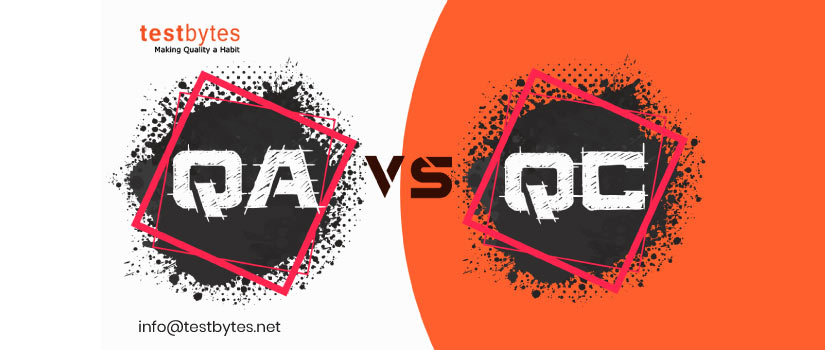
Quality Assurance (QA) vs Quality Control (QC)
January 25th, 2019

Organizations often use the terms ‘Quality Assurance’ (QA) vs ‘Quality Control’ (QC) interchangeably. However, they both represent two very different aspects of quality management!
Understanding the exact meaning of these two terms under quality management is very important for every organization. This is because every client and customer’s top priority is always the quality of the product being delivered to them! Therefore, it is very essential to conduct both QA vs QC independently to increase the overall quality of their product.

First, let us look at the meaning of the different terms:
- Quality-The quality of any product is determined by how well it meets the expectations and requirements of the customer. This means that the product must be free from errors, inconsistencies and lacking in some particular aspects. There are always some standards in terms of quality that need to be met in order to satisfy the requirements of the customers.
- Assurance- It is the act of guaranteeing the customers, that the product being delivered fulfills their preferred quality level. It is done to give security that the end product will be error-free and will satisfy all requirements.
- Control- It is the process of determining whether the end product matches all customer requirements or not. It involves testing and comparing the actual result with the desired result.
Quality Assurance
Also referred to as QA, it is a process-oriented activity whose main focus is the prevention from defects in a product. It ensures that the methodology, techniques, procedures, and approaches for the products are designed in a correct manner.
It is a proactive activity where flaws and inconsistencies in the development process are recognized and rectified.
According to ISO 9000, Clause 3.2.11, Quality Assurance is defined as ‘An aspect of quality management that deals with providing confidence to customers that requirements set for quality will be fulfilled’.
QA- A Prevention Activity
QA entails the proper creation of plans, documentation, and agreement on guidelines that assure quality.
The planning phase is executed at the very beginning of the project. It is done according to the specifications of the software as well as the industry and company standards. The outcomes generated at the end of this phase usually include quality plans, test plans and inspection, selection of tools for defect tracking and training people in selected processes and methods.
It is critical to undertake QA activities during the project’s beginning, so as to avoid risks that have been identifies in the specification phase. Another critical factor in QA is effective communication for managing the project risks. The various aspects of the risk mitigation strategies must be effectively communicated to the project’s development teams.
Quality Control
Also referred to as QC, it is a product-oriented activity whose main focus is to identify defects in the quality of the product. It checks whether the methodology, techniques, procedures, and approaches designed for the product have been followed diligently, in a correct manner.
Therefore, it does not focus on the process, rather the focus here lies on the end product.
According to ISO 9000, Clause 3.2.10, Quality Control is defined as ‘An aspect of quality management that focuses on fulfilling the quality requirements for the product’.
QC- A Detection Activity
QC entails all activities related to determining the quality level of the delivered product. It includes operational techniques that have been agreed upon by the customers before the commencement of the project, to fulfill quality requirements.
During this process, the output received, or the end product is confirmed to the software requirements and verified for its quality. That means, the product is checked at various stages of the development life cycle and also against the requirements set by the customers. Different types of tests, code inspections, structured walk through, and various other techniques are used during QC.
The Need for Quality Management
Quality management is very important to ensure that only the best products are being developed and delivered to customers through well planned and structured projects.
Here, the process of QC works parallel with the process of quality improvement to identify and isolate the root causes that generate quality problems. When done consistently across the project, it provides effective feed backs on the quality problems, which facilitates in the development of effective strategies to eradicate such problems.
Through such processes, higher quality level products can be delivered to the customers. Therefore, the benefits of quality management include:
- A higher level of customer satisfaction, that translates into a better brand reputation in the industry.
- A development team who is much more motivated to actively participate in quality assurance and control processes.
- Elimination of redundant tasks to address gaps in processes to meet requirements.
- Properly planned methods and process, as unplanned processes lead to rework, which needs to be avoided.
Difference between Quality Assurance and Quality Control
|
Category |
Quality Assurance |
Quality Control |
| Meaning | The process of guaranteeing that the set quality levels will be fulfilled by the product at each phase. | The process of detecting errors in order to ascertain that quality standards are being fulfilled. |
| Focus | The focus is on Process of product creation | The focus is on the actual end Product |
| Approach Used | QA uses a very proactive approach | QC uses a very reactive approach |
| Aim | Aims at preventing errors from occurring by thorough planning of activities and proper documentation | Aims at finding out prevalent errors by checking whether the planned activities have been followed correctly |
| Emphasis | QA stresses on the customer requirements | QC emphasizes on the standards set by the industry or the company |
| Example | QA provides verification that the product’s quality level will be met | QC provides validation that the quality level is actually being met |
Now that the basic differences have been discusses, we can go deeper into these key factors on which Quality Assurance and Quality Control differ from each other.
The 10 main differences between them are:
1. Quality Assurance gives a sense of confidence to the customer, by providing him assurance that the requested quality standards will be met by the delivered product.
Also Read: Why Testbytes is the leading Software Testing and QA Company India?
Quality Control, on the other hand, ensures that the quality standards are actually being met at every phase of the product’s development life cycle.
2. While Quality assurance is called as a proactive approach, as it is conducted during the development process of the product, Quality Control is called as a reactive approach, because it takes place after the end product is developed.
3. The aim of Quality Assurance is to create plans, methods, processes, etc., which can help in the prevention of any defects in the quality. However, Quality Control’s aim is to find out any defects that might be present in the end product, after its complete development.
4. QA helps to verify that the quality of the product, meets the set standards, by creating documentation, proper planning, etc.
5. QC helps in validating that the product is defect free and actually meets with all the set standards for quality requirements.
6. Quality Assurance is conducted throughout the software development life cycle.
7. Quality Control is conducted during the software testing life cycle.
8. Statistical techniques are used for both the processes. While the statistical technique used in QA is called (SPC) Statistical Process Control, the technique used in QC is called (SQC) Statistical Quality Control.
9. During Quality Assurance, standards, methodologies, and processes are defined that can help in achieving the level of quality that the customer desires.
During Quality Control, test, code analysis, and various other techniques are conducted in order to ensure that the set level of quality is being achieved.
10. Quality Assurance is a low-level activity that is also less time-consuming. It does not involve the execution of the program.
On the other hand, Quality Control is a high-level activity that is more time to consume as it always involves the execution of the developed program.

Conclusion
In conclusion, both QA vs QC contribute to making a product error and defect free, to ensure a very high level of product quality. Although their aim is somewhat similar, their approach varies dynamically.
Through Quality Assurance, a comprehensive process is designed that can lead to the development of a defect-free product if followed in a proper manner. While through Quality Control the process and the end product are thoroughly checked and tested to reveal any defects in it.
For the success of any project, it is very important to conduct these two processes under Quality Management. The more effectively they are conducted; the better will be the quality of the end product. This can ultimately help to gain more customer satisfaction and a better organization reputation in the industry.


 Software Testing Events
Software Testing Events App Testing
App Testing Web App Testing
Web App Testing Game Testing
Game Testing Automation Testing
Automation Testing Load Testing
Load Testing Security Testing
Security Testing Performance Testing
Performance Testing Hire a Tester
Hire a Tester





